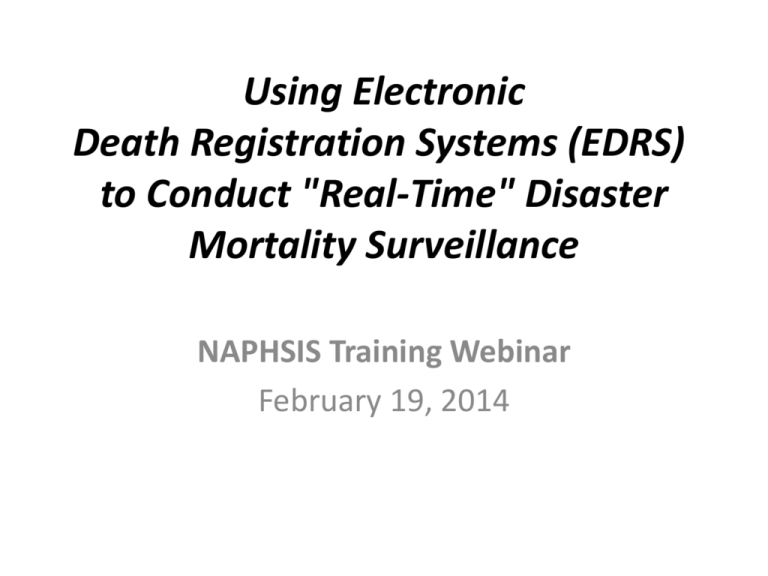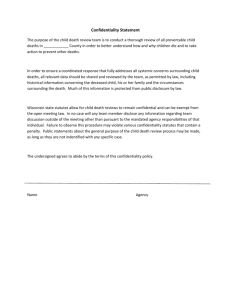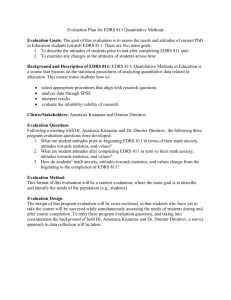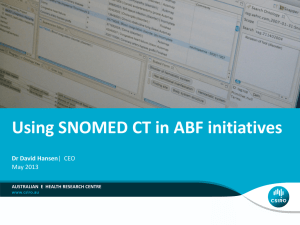All_EDRS_seminar_ppts_V6 - National Association for Public
advertisement

Using Electronic Death Registration Systems (EDRS) to Conduct "Real-Time" Disaster Mortality Surveillance NAPHSIS Training Webinar February 19, 2014 Overview • Jurisdiction experiences using EDRS during disaster response – Oklahoma: Kelly Baker – New York City: Renata Howland – Alabama: Cathy Molchan • CDC will present a conceptual framework to leverage EDRS for disaster mortality surveillance system • Q and A session with participants What is surveillance? • Public health surveillance is the continuous, systematic collection, analysis and interpretation of health-related data needed for the planning, implementation, and evaluation of public health practice. Such surveillance can: – serve as an early warning system for impending public health emergencies; – document the impact of an intervention, or track progress towards specified goals; and – monitor and clarify the epidemiology of health problems, to allow priorities to be set and to inform public health policy and strategies. (WHO website: http://www.who.int/topics/public_health_surveillance/en/) What is surveillance? • …continuous, systematic collection, analysis and interpretation… – Continuous: 100% Deaths collected through vital statistics for now and in future – Systematic: Can be through EDRS and coordination across jurisdictions – Analysis and interpretation: By vital stats or other programs? What is surveillance? • …warning system for impending public health emergencies… – What is “impending” given deaths already occurred • Post-disaster risk due to environmental conditions • Mental health • Repeat catastrophies Electronic Death Registration - Oklahoma Kelly M. Baker, MPH State Registrar and Center for Health Statistics Director Oklahoma State Department of Health EDRS Webinar Series - 2014 What is an EDRS? • Electronic Death Registration System • Allows record participants to file death certificates – On-line, Anytime, from Anywhere (with internet access) • Hospital, home, office, vacation • Jurisdiction Goals – More timely, more complete, more secure, more accurate, minimize business costs, improved service to families • Funded in part by SSA since 1999 – 24 hr death report sig reduce incorrect payments to beneficiaries* – Terminate benefits to deceased immediately* – Improve accuracy of data shared with other Federal agencies* *SSA contract/award background statement Why Register Deaths Electronically? • Paperless filing of a death record – Funeral Dir is no longer physically chasing a physician for signature – Collaborative registration process between funeral home, physician, nursing homes, ME, and Registrar • Improves timeliness and data quality – – – – Promote family support Automatic edits Proactive follow-up by VR More timely data (public health, benefit resolution, etc.) • Fraud Prevention – Automate birth/death linkages to prevent identity theft – Secure signatures by physician and funeral director • Verify SSN against SSA system before record registered Savings Realized • Funeral home – Reduced visits to Drs for signature, e.g. time, gas, etc. – System auto-verifies and auto-notifies SSA, Auto-pops applications • Family – Records placed on file quicker for earlier benefit resolution • State – Modify electronic form vs dispersal/storage of paper forms – On-line communication/training – Reduced number of staff needed to process amendments • SSA – Prevent erroneous payments • Jan 2014: average payment per retired worker $1,183/mo* • Jan 2014: 39,762,000 people receiving SS only (no SSI) age 65+* *SSA website How EDR Has Made a Difference - Oklahoma • Time from event to filing – Before EDRS: 13 days After EDRS: 7 days – Note: Only 54% filed completely electronically so far! • Lag time between date of registration and date sent to NCHS – Before EDRS: 29 days (2008) After EDRS: 1 day (2013) – Promotes faster national datasets for Public Health • Lag time between DOD and date sent to SSA – 2012 Q1: 93% within 1 month: 23% 1-6 days – 2013 Q3: 98% within 1 month: 44% 1-6 days 70% 7-30 days 54% 7-30 days • Amendments – Processing time: Before EDRS: 75 min each (2,546 Man hours in 2008) After EDRS: 1-2 min each ( 166 Man hours in 2012*) – Improved data quality: Auto edits on SSN, DOB, DOD and Age allow us to refocus efforts on Public Health/statistical items* • Specific Cause of Death, Smoking, Pregnancy, Condition onset *76% more records amended in 2012 compared to 2008 System Costs • Variability – – – – – – State size In-house development vs vendor Equipment/licensing needs e.g. upgrades Integrate other modules e.g. birth, fetal death, point of sale Data conversion may be required Timing • Oklahoma – – – – Users: ~ 2,000 funeral directors, physicians, and assistants Death module ~$700,000 Total vendor cost (B/D/FD/POS/5 yr maintenance): $3.2 mil Received $494,000 from SSA (2005) May 20, 2013 - Moore, OK • F5 tornado 1.3 mi wide at peak • Touched down Monday 2:56pm • On the ground 39 min; 17 mile path • 25 killed (1 indirect) – Initial reports as high as 91 • 377 injured • ~1,150 homes destroyed • F5 tornados took similar paths May 3, 1999 and May 8, 2003 • Preliminary damage estimates > $2 billion Impact During A Crisis Response • DCs filed by Medical Examiner within 4 hrs of F5 tornado – Immediately ready for transmission to Funeral Homes • System automatically linked deaths to Oklahoma births – Deaths to those born/reside outside OK immediately sent to appropriate state • Records were flagged as catastrophic event for future analyses and tracking • Contribute to accurate public reporting of casualty counts • Deployment for on-site issuance of BCs to victims – Assist with re-establishing identities With Additional Funding • Physicians – – – – Better integration with the OCME system Improve/expand the training & support of physicians Support mandated physician use Develop more user friendly interfaces to improve compliance • Data Enhancements – – – – Audit medical records to improve COD quality Automatic geocoding of records Implement in states without EDR – fill in national gaps Enhance Continuity of Operations capacity • Reporting – Make real-time reporting of aggregate data available online – Enhanced data analysis e.g. economic impacts to families, communities, nation from all CODs Source: NAPHSIS Tracking Deaths in “Real-Time” during Sandy, New York City Renata Howland, MPH CSTE/CDC Applied Epidemiology Fellow Acknowledgements Bureau of Vital Statistics Elizabeth Begier, Wenhui Li, Ann Madsen, Howard Wong, Tara Das, Flor Betancourt Bureau of Environmental Surveillance and Policy Thomas Matte Bureau of Environmental Disease Prevention Catherine Stayton Office of the Chief Medical Examiner Leze Nicaj CDC, National Center for Environmental Health Rebecca Noe Presentation Objectives 1. Describe death registration and surveillance during and after Hurricane Sandy 2. Summarize findings and uses 3. Identify lessons learned and next steps Hurricane Sandy • On October 29, 2012 Sandy made landfall approximately 100 miles south of NYC • Record storm surge and high winds – Flooding across coastal areas – Widespread power outages – Transit shutdown • On-going environmental hazards Mortality Surveillance 1. How many Sandy-related deaths occurred during the storm? 2. Was there an increase in all-cause mortality following the storm and if so, why? Electronic death registration system (EDRS) • Web-based platform implemented in 2005 – By 2010, >90% electronically reported • Data providers: – Clinicians – Funeral directors – Medical examiners Death Registration Flow Chart Death Clinician medically certifies 24 hours Electronic Death Registration System Medical examiner investigates Line List Preliminary death record Death Registration Flow Chart Death Clinician medically certifies Funeral director completes 24 hours + 48 hours Health Department registers Electronic Death Registration System Medical examiner investigates Preliminary death record Line List Preliminary data file Registered death record Death data file Sandy Surveillance • Received line list from medical examiner office within 24 hours of death • Searched cause of death text fields • Monitored news/media inquiries • Activated popup notice If Hurricane Sandy was the direct cause of this death or contributed to this death either directly or indirectly, please report the death to the NYC Office of Chief Medical Examiner (OCME) at xxx-xxx-xxx before certifying the case. Please include cases involving cold stress or carbon monoxide exposure occurring in residences without heat. Do not continue with the case if OCME is taking ownership. Sandy Surveillance • Ran daily death reports compared to 2010-11 – Extracted preliminary records to improve timeliness (~2 days) – Summarized by age, cause of death, and proximity to flooding • Daily reports run for two months and distributed to emergency response personnel FINDINGS Direct injury fatalities • 44 deaths were Sandy-related – 41 identified by November 2 – 2 additional deaths identified by Nov 11 – 1 death discovered in June 2013 • Deaths were primarily the result of drowning – Did not represent an on-going hazard (e.g., carbon monoxide poisoning, falling trees) Cause of Death Drowning Blunt Impact Other All-cause mortality • Increase in all-cause mortality compared to 2010-2011 – Preliminary records signaled increase, underestimated compared with registered death records – Not concentrated by age, cause, or proximity to flooding Percent Differences in All-Cause Deaths Counts in 2012 compared with 2010-11 averages, from October 1 – December 31, New York 40.0% Influenza Season 30.0% Percent Difference 20.0% 10.0% 0.0% OCTOBER NOVEMBER -10.0% -20.0% Hurricane Sandy -30.0% -40.0% *Deaths were registered as of December 31st of each year DECEMBER Median Days to Medically Certify and Register Deaths by Year (Oct 29-Nov 10) 3.5 3.1 3 Days 2.5 2.2 2.3 2010 2 2011 1.5 2012 1 0.5 38% increase 0.38 0.30 0.36 0 Medically Certify Register LESSONS LEARNED Challenges • Operational: – Disruptions to infrastructure – Health Department building closed for approximately 1 week – Internet down at hospitals Challenges • Analytical: – Manual processes were time consuming – No pre-established summary reports – Preliminary records not complete – No internal definition of Sandy-related Strengths • • • • Electronic system stable, remotely accessible Coordination with data providers Timely identification of deaths Minimal additional resources – Local capacity to code, extract, & analyze data • Demographic, cause, and area-specific information on decedents for exploring trends Next Steps • Publish evaluation of EDRS surveillance • CDC grant to study mortality in depth • Additional grant to develop more advanced reports and consider system enhancements • Collaboration with other programs – Red Cross/EDRS linkage to examine data quality and circumstances related to death Thanks! Contact information: Renata Howland rroney@health.nyc.gov 646-632-6728 Catherine Molchan Donald State Registrar and Director Alabama Center for Health Statistics Cathy.molchan@adph.state.al.us The ability to coordinate with other organizations (e.g. law enforcement, healthcare, emergency management, and medical examiner/coroner) to ensure the proper recovery, handling, identification, transportation, tracking, storage and disposal of human remains and personal effects; certify cause of death; and facilitate access to mental/behavioral health services to the family members, responders, and survivors of an incident. http://www.cdc.gov/phpr/capabilities/capability5.p df Determine role for public health in fatality management Activate public health fatality management operations Assist in the collection and dissemination of antemortem data Participate in survivor mental /behavioral health services Participate in fatality processing and storage operations EDRS, or an Electronic Death Registration System, is a software system that allows death certificates to be registered electronically Built in edits help reduce errors Drop down boxes for education, county of death and other common items help reduce errors The need for carrying/mailing paper death certificates is eliminated – time to register a death certificate is reduced Certified copies of the record can be issued to families more quickly Ensuring that the particular mass fatality event is recorded on the death certificate Ensures the cause of death will be properly coded to the specific type of Mass Fatality Reaching out to Medical Certifiers to ensure this happens Documenting accurately place of death or where the body was found Delays in finding and identifying some bodies Indirect causes of death Depending on the type of event; deaths can be spread over time and distance Two tornado outbreaks in Alabama in April 2011 April 15/16 resulting in 7 deaths April 27 resulting in 237 deaths First warning 4:16 am Last warning 9:48 pm Crash of an airliner in concentrated area Pandemic In 2011, Alabama was piloting EDRS Varying number of deaths based on source Number of deaths 250 200 206 150 100 50 0 20 3 1 1 1 1 Day and month 1 1 1 1 Who is planning for responding to a Mass Fatality Event in your State? Are State and Local Vital Records Offices involved in the planning? Does your State have an Electronic Death Registration System (EDRS)? Can information on Mass Fatalities be readily obtained from the EDRS? What percentage of death records are filed electronically? Getting all the players to the table; Vital Records, Emergency Preparedness, Epidemiology, Coroners and Medical Examiners Thinking about and document the information that will be needed and when it will be needed Be as specific as possible so an EDRS can be modified to meet the needs How quickly do you need information? Preliminary vs. Final Discuss different Mass Fatality events and how the information needed might differ Discuss funding for enhancements to an EDRS to meet surveillance and emergency preparedness needs Consider your sister states in the process Work together to fill in the empty space on Capability 5 More information will be forthcoming regarding the role of the NAPHSIS Mass Fatality Committee in this effort Thank you for your time and attention Electronic Disaster Mortality Surveillance – Is It Possible? A Conceptual Framework CDR Rebecca S. Noe MN, MPH, FNP-BC Health Studies Branch, National Center for Environmental Health Centers for Disease Control and Prevention NAPHSIS Seminar February 19, 2014 National Center for Environmental Health Division for Environmental Hazards and Health Effects Objectives • Present how disaster-related deaths are being tracked in the U.S. • Share a framework to leverage Electronic Death Registration System (EDRS) to track all disaster-related deaths in a timely fashion • Describe challenges in using EDRS and potential solutions Importance of Disaster Mortality Data • Guide response effort • Qualify families for FEMA funeral benefits • Maintain record of disaster-related deaths in the National Vital Statistics System (NVSS) for epidemiologic research • Link disaster-related fatalities to an event in NOAA’s Storm Data system NOAA’s Storm Data • • • Purpose to record extreme weather and climate events; economic and health impacts Fatality data not uniformly collected Multiple data sources but no death certificates Storm Data Fatality Information • • • • • Age Gender Date of Fatality Location of Fatality Direct or Indirect Implications • Unverified deaths attributed to specific weather events • Impacts disaster research and national preparedness policies – Weather and climate scientists depend on Storm Data information – Congressional and other gov’t agencies request NOAA disaster reports – Underreporting especially indirect disaster-related deaths Disaster Mortality Surveillance • Electronic Death Registration Systems (EDRS) – – • In 38 of the 57 vital records jurisdictions Messaging application (STEVE*) permits the electronic exchange of vital event data between jurisdictions and to federal agencies Death certificates could be the “gold standard” to record disaster attributable mortality *State and Territorial Exchange of Vital Events Response Agencies Identifying Disaster-related Deaths Previous Disaster Deaths Identified Data Source Number of Disaster-related Deaths Identified Red FEMA Cross NOAANWS Storm Data Other State Agency (EOC, ME) EDRS (Search without names) Hurricane Ike – TX (2009) 38 ? 20 74 4 April 27 Tornado – GA (2011) 15 ? 15 15 6 Hurricane Sandy – NJ (2012) 34 ~700 12 75 8 Really, Disaster-Related Deaths Not in the EDRS? Case 1 not identified initially Case 2 was identified initially Because no indication that COD or consequences were disaster-related Because circumstance indicated this was disaster-related But determined as disaster-related via other data sources Without this information, other data sources would be required Challenges of using EDRS for Disaster–related Mortality Surveillance • Disaster-relatedness often missing • Injury circumstances only captured • Indirect deaths underestimated Challenges (2) • Text string search capabilities vary • Variety of persons completing death certificate • Pending cause(s) due to legal implications Possible Solutions • State registrars in an ideal position to assess if disaster-relatedness on certificate • EDRS built in capacity to “flag” or do text searches are necessary for emergencies • Mass fatality plans could encourage that relatedness be recorded on death certificate Possible Solutions (2) • Verify disaster-related deaths after an event • Provide training and guidance on certification to medical examiners, coroners, and other certifiers – Disaster-related deaths (e.g., hurricanes http://www.cdc.gov/nchs/data/dvs/hurricane_certification.pdf) • Provide disaster mortality surveillance guidance Conceptual Framework During a disaster identify and indicate disaster relatedness on death certificate Use FEMA and Red Cross to cross check State EDRS NOAA Storm Data and Other Key Partners Information securely transmitted via STEVE Conclusion • EDRS can be leveraged for timely disaster death identification and surveillance • Electronic disaster mortality surveillance is possible and useful – – – – – Improve timeliness and accuracy Guide response efforts Enables states to answer inquiries rapidly Measure and record the true burden of disasters Provide accurate information for disaster research Thank you DISCLAIMER: The findings and conclusions in this report are those of the authors and do not necessarily represent the official position of the Centers for Disease Control and Prevention. Q and A Session ADDITIONAL SLIDES OCME definition • Injuries directly related to the storm or indirectly related, where the individual did not have a chance to avoid the hazard • E.g., falling down the steps as a result of no electricity the night of the storm would be Sandyrelated, but three days later it would not as the decedent had time to seek shelter elsewhere or use other sources of lighting while the power was out Text String Search Terms Suffocation Drowning Submerge Poisoning Impact Asphyxia Traumatic Injury Fractures Electrocution Hypothermia Carbon Monoxide Struck Crushed Blunt Injuries Object Debris Fall Tree Motor Vehicle Crash Collision Automobile Truck Flood Signal Road Light Puncture Fire Burn Sandy Pedestrian Fumes Heat Inhalation Toxic Smoke Storm Hurricane Immediate Cause Hours Intermediate Cause Days Intermediate Cause Months Underlying Cause Years Other significant conditions





